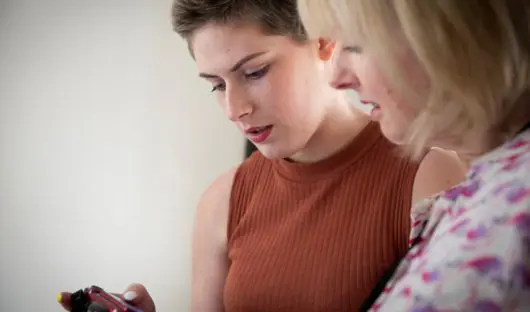Diagnosis and tests for cancer
Tests play a big part in the diagnosis and treatment of cancer. It can be stressful waiting for results, but the more information your team has, the better they’ll be able to help you. At first, the tests will help doctors figure out what type of cancer you have and where it is in your body.
Be heard and understood
You might not want to deal with medical stuff right now. It’s fine to leave it to your parents or partner if that’s what you want. But if you want to know what’s going on and play an active role in your treatment, it’s important that your questions and thoughts are listened to by professionals.
Some doctors are brilliant at communicating. Others, not so much. Remember:
- Note questions down beforehand.
- Write down the answers so you can refer to them later – or get someone to do it for you.
- You always have the choice to talk to a professional in private, especially if you need to
discuss medical history or lifestyle. - Don’t be afraid to say you don’t understand medical jargon – ask your doctor to explain what it means.
- Make sure you know the next steps.
- Lots of adults find it awkward discussing their bodies so openly but there is nothing that these professionals won’t have heard before.
If you think you’re pregnant
It’s really important to tell your doctor and people doing your tests if you’re pregnant, or think you are. They’ll need to know so they can protect you and your baby, especially during scans and treatment. You can always ask to speak to them privately if you need. Just make sure you tell them.
The A-Z of tests you might have
A biopsy is where a small part of a lump or tumour is taken and tested to find out more about it. There are different types of biopsies. Many of them will only need a local anaesthetic and are straightforward and painless. Some might require a sedative or general anaesthetic. Your doctor should be able to talk you through it.
Blood tests are usually done before, during and after treatment. Reasons for blood tests include:
- Detecting cancer
- Checking for infection
- Monitoring how well treatment is working
- Monitoring the side effects of treatment
- Making sure your body’s systems (such as your liver or kidneys) are still working properly
- Matching your blood with a donor’s if you need a transfusion
- Monitoring your blood count (the number of red and white blood cells and platelets in your blood).
Bone marrow is the spongy tissue found inside certain bones. It contains stem cells, which develop into blood cells. Bone marrow tests are usually done for cancers that affect the blood, like leukaemia. You’ll be given a local anaesthetic to numb the area, plus a sedative to make you drowsy, or a general anaesthetic so you’re completely asleep. A needle is inserted into the bone to draw out some of the bone marrow, which is checked in the lab. The test can feel uncomfortable but your team should make it as easy as possible for you.
This type of scan highlights rapidly growing or changing areas of your bone. A small amount of radioactive fluid, called a tracer, is injected into your vein to travel to your bones. Don’t worry, it won’t harm you. The liquid will collect in areas where your bones aren’t acting normally (called hot spots) and will show up darker on a scan.
Also known as CAT or computerised tomography scans, CT scans use X-rays to get images of the inside of your body. It only takes a few minutes and the worst part is lying so still! Sometimes you might need an injection to help different parts of your body show up clearly.
This procedure is used to test the fluid around your spinal cord to see if it contains cancer cells. This is usually if leukaemia, lymphoma or other tumours are suspected. It tests whether the cancer has spread to this fluid from somewhere else in the body.
You’ll be given a local or general anaesthetic beforehand and lie curled up on your side. A needle is inserted between the bones in your lower spine and a few drops of fluid is collected. It sounds scary but usually it’s just a bit uncomfortable and not as bad as lots of people fear. Some people get headaches afterwards so you’ll probably be advised to lie flat for a while to try to prevent one.
During an MRI you’ll lie on a flat bed that’s moved into a scanner. It uses magnetic waves to create detailed images of the inside of your body. It’s pretty narrow and loud but you’ll be given headphones and will be able to talk to the radiographer through an intercom. The scanner might also be fitted with music or DVD player. It can last up to an hour so it’s worth asking in advance in case you want something to keep you occupied while you lie super still. Like the CT scan, sometimes an injection is given beforehand to make a part of the body more visible.
Positron emission tomography, otherwise known as the more memorable PET, scans measure how much glucose – or sugar – parts of the body are using. It seems a bit random, but it’s because cancer uses more sugar than normal cells a lot of the time. They’re similar to CT scans in that you’ll need to lie still on a bed which moves into a machine. Before the scan, you have an injection of a sugar solution with a small amount of radioactivity. Don’t worry, it’s safe – you’re not going to turn into the Incredible Hulk!
After the injection you have to lie still for up to an hour while the radioactive glucose gets into your tumour cells. Lying still stops the sugar solution going to your muscles, which can make it harder to understand what the scan shows. It’s also important to stay nice and warm while waiting for the scan. The scanner then moves over your body, and picks up areas where the radioactive sugar is more concentrated. After the scan, your body quickly eliminates the radiation. You can ask the people at the scan centre to give you more information about this.
Ultrasounds use sound waves to show unhealthy tissue inside your body, especially your heart, liver or kidneys. An external ultrasound scan is the same one pregnant people have to monitor an unborn baby. You might be asked to remove some outer clothing depending on where the scan is. The person doing your scan will put some gel on your skin, which might be a bit cold. They’ll move a hand held ‘wand’ around, pressing it over the part of your body being scanned while viewing an image on a screen. Sometimes, ultrasound scans are internal – often for scanning your prostate or vagina. It might be uncomfortable but shouldn’t hurt and won’t take long either.
An X-ray is a painless procedure which produces an image of the inside of your body. They can help diagnose tumours and can be used for other things, like checking for a chest infection. If the picture isn’t obvious, more scans might be needed to get better detail. You’ll need to take off any jewellery or clothing with any metal. If you have body piercings, check with the doctor or radiologist – there’s nothing they won’t have seen or heard before!
Getting the results
One of the main reasons for having all these tests will be to find out how ‘advanced’ your cancer is. When it comes to the results, there are two main things to understand:
- Staging: the stage describes how big the tumour is and how far it has spread from where it
started - Grading: this tells you how much your cancer cells have changed, compared to a normal cell. These are the basics but sometimes doctors will include more categories.
The result might be a jumble of numbers and Roman numerals that don’t mean much. So it’s important that your team explains simply and clearly what these results mean. If you don’t understand, do not – repeat – do not google it. There are so many variables that what means one thing for someone else won’t necessarily mean the same for you. Go back to your medical team to get the right information about what these results mean for you.
Whatever the outcome, of course you’re going to be worried. The bottom line is, knowledge is power and the more everyone knows about your illness, the better they’ll be able to treat you.
If you have a fear of needles
If you have a needle phobia then the thought of tests and treatment might be very distressing. It’s common to dislike needles but a phobia is when you actively avoid them and experience physical symptoms such as anxiety, feeling faint, a dry mouth, trembling, an upset stomach, increased heart rate and shortness of breath. The best thing you can do is to talk to all the people involved in your care.
The people doing your tests will have experience helping people with fears and will do what they can to make it easier, like chatting to distract you, keeping medical equipment out of sight and or letting you lie down. Don’t worry – they’re not going to judge you. You could also play some music or a podcast, download a meditation or mindfulness app, practise slow breathing and calming techniques, or keep some sugary food or drink close by if you feel faint.
For many people, the more they do it, the less terrifying it becomes. Speak to one of the professionals looking after you or a health play specialist at your hospital. They could give you advice and support, or refer you on to the hospital’s psychology service if they have one. In the long term, you could ask your GP about accessing hypnotherapy, cognitive behavioural therapy (CBT) or neural linguistic programming (NLP) – these are all thought to help with getting to the underlying cause of your fear and overcoming it. The most important thing to remember is that, no matter what, you will get through it and there’ll be plenty of people there to help.
You might also like to read
Going to hospital for the first time
A guide to going to hospital for the first time and what you can expect as a young person.
Read more
How bad will treatment make me feel?
Everyone reacts differently to treatment. Here are ways to combat any side effects.
Read more
Where will I have my treatment and do I get a say?
If your place of treatment hasn't been decided, it’s important you ask about your options.
Read more